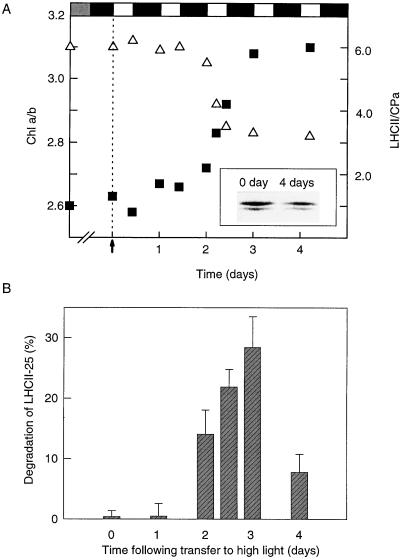Figure 1.
Induction of LHCII degradation and activation/deactivation of the LHCII protease during acclimation of spinach plants from low- to high-intensity light. Spinach plants grown at low light (30 μE m−2 s−1) were transferred to high-intensity light (600–800 μE m−2 s−1). The light/dark cycle was 10 h of light followed by 14 h of darkness. A, Thylakoid membranes were isolated during the acclimation period, and the reduction of the PSII antenna was followed by measurements of the chlorophyll a/b ratio (▪) and the LHCII/PSII core (CPa) ratio (▵), as determined by mild SDS-PAGE. Each point is the mean of four to six separate experiments. The arrow indicates the time when the plants were transferred to high light. The inset shows the relative amounts of the LHCII-27 and LHCII-25 polypeptides before (0 day) and after (4 days) high-light acclimation, as analyzed by Coomassie blue-stained two-dimensional SDS-PAGE. B, Thylakoid membranes isolated from leaves at various stages of acclimation were washed with a high-salt buffer to release the protease extrinsically bound to the outer membrane surface. The desalted and concentrated wash supernatants were tested for proteolytic activity by addition to washed high-light thylakoids. The degradation of LHCII was analyzed with SDS-PAGE and western blotting. Results are the means of three independent experiments + se. Chl, Chlorophyll.

